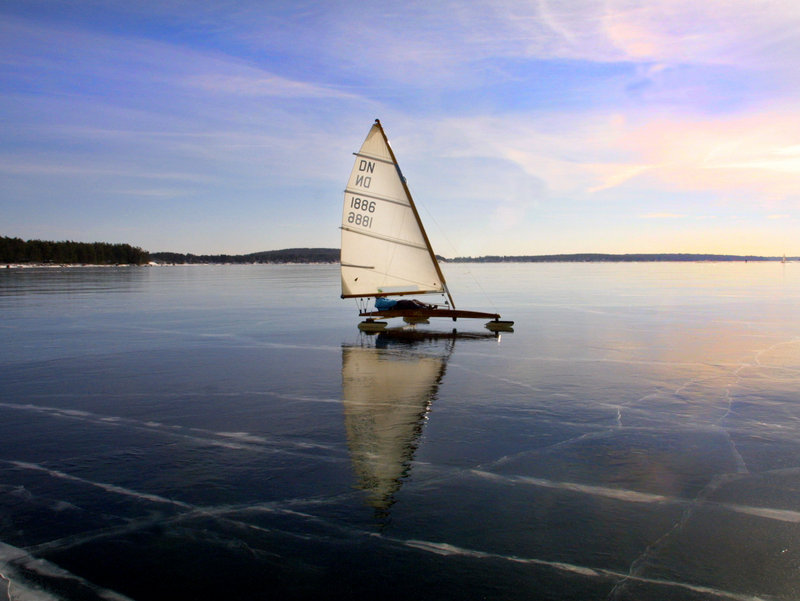As the season draws to an end, boaters find themselves with the age-old question of how to get through the long, cold Maine winter.
Some enjoy winter sports like skiing, snowshoeing or snowmobiling. Many will spend the off-season on boat improvement projects. Others will go south and charter a boat for a week or two. The really lucky ones take their own boats south and spend the winter where it’s warm.
Then there’s a group of die-hard adventurers who will be looking for every opportunity to sail right here this winter. Members of the Chickawaukie Ice Boat Club (CIBC), based in Rockport, and ice boating enthusiasts across New England know that sailing can be just as fun — maybe even more so — on “hard water.”
“The club was founded in the 1960s by off-season yacht captains with a passion for ice boating,” according to its president, Bill Buckholtz.
Ice boats, like their “soft water” counterparts, come in a variety of shapes and sizes, the most popular being the International DN. It measures 12 feet long, with a 21-inch wide cockpit and an 8-foot wide runner plank. The front runner is typically rigged with a steering rod that connects it to a tiller mounted just aft of the mast base.
The boat weighs 100 pounds, and is piloted by a single helmeted sailor. The 16-foot mast supports a single mainsail of up to 70 square feet.
“The DN is great — it’s easy to learn to sail, cheap to buy and you can carry it on the roof of a car,” says Buckholtz. “You can find a good sailing DN for around $1,500. If you’re clever and mine the internet effectively, you might find one for less.”
Ice boating is a somewhat physical sport.
“If you’re racing, you have to push the boat to get started, then vault into the cockpit, so you have to be nimble,” says Buckholtz.
Strong leg muscles are helpful, and so is upper body strength, since sailors need to unload boat parts from their vehicles and bolt everything together.
Buckholtz adds that DN operators have their own special way to get into shape.
“Operators of the DN lie on their back in the cockpit and have to hold their head up with a helmet on,” he says. “This time of year, guys will lie on the floor and watch TV with a helmet on to get in shape.”
Buckholtz adds sit-ups and pull-ups to his own conditioning routine, but points out that one doesn’t have to be in exceptional condition to enjoy the sport.
One of the biggest differences between soft- and hard-water sailing is the speed. With good ice and a decent breeze, ice boats can reach speeds in excess of 40 miles per hour. CIBC members who clock 60 or more get a special sticker for their craft. And while such speeds carry some risk, Buckholtz says serious injuries are rare.
“You can fall off an ice boat, but you just slide, and usually there’s no harm done,” he says. “The helmet is more for keeping boat parts from hitting you in the head rather than hitting your head on ice.”
A big challenge for ice boaters is to find the best ice. Lake Chickawaukie’s coastal location means it often gets rain and refreezes when other lakes get snow. Club members constantly scout various locations and communicate via email and the club’s blog at http://iceboat.me/.
The club, which has 100 members throughout New England and a local membership of about 15, is always looking for new members. Dues are $10 a year, and for that, members get on the mailing list, can attend any of the club’s gatherings, and can take a boat for a spin.
It’s something for skiers to think about if Maine has a bad snow year. Just remember to dress warmly and bring your helmet.
Gail Rice of Freeport and her husband, Randy, race and cruise their Pearson 30 sloop on Casco Bay. Contact her at:
gnrice@yahoo.com
Copy the Story Link
Send questions/comments to the editors.



Success. Please wait for the page to reload. If the page does not reload within 5 seconds, please refresh the page.
Enter your email and password to access comments.
Hi, to comment on stories you must . This profile is in addition to your subscription and website login.
Already have a commenting profile? .
Invalid username/password.
Please check your email to confirm and complete your registration.
Only subscribers are eligible to post comments. Please subscribe or login first for digital access. Here’s why.
Use the form below to reset your password. When you've submitted your account email, we will send an email with a reset code.